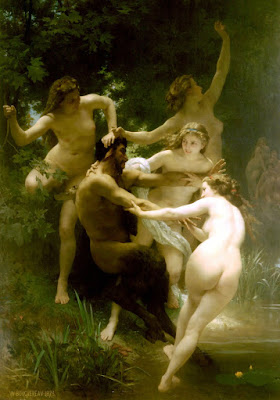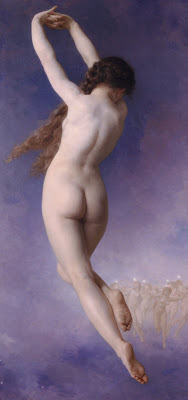This week I'm going to post two images per day of Bouguereau’s work--one piece that I like and one that I don't.
Nationality: French
Born-Died: 1825-1905

Nymphs and Satyr
Creation Date: 1873
Size: 102.4 x 70.9 in. (260 x 180 cm)
Media: Oil on canvas
Location: The Clark Art Institute, Williamstown, Massachusetts, USA
Although I will never hang a reproduction of this painting on my wall, there are things I enjoy and respect about it. It has brilliant lighting with a wonderful and inviting warm cast. Although only one large beam lights the scene, through clever artistry, Bouguereau painted each figure with a different overall lighting scheme from the others. The reflected light that bounces off the environment and the pale figures onto other figures is handled with superb sensitivity to both stylistic effect and realism. The same can be said for the clever use of the background tonalities, which range from having high value contrast on the left to more unified tonalities on the right. Despite the sharp clarity with which the figures are represented they do not appear unnaturally stiff.
The subject--a group of nude women pulling a man into a pond for a dip--is whimsical and I appreciate the positive, lighthearted content of this piece. I think one of the best decisions Bouguereau made in regards to this painting was the choice to depict the ground as very slanted--this brings a sense of movement and bustle to the image, enhancing the playful, energetic quality of the scene. Bouguereau's compositional approach was often limited to "sticking it in the middle" but this painting is more full. To elaborate on that idea, more of the canvas is used to convey the idea of the painting and the result is that the piece appears to be a more serious and thorough work.

Lost Pleiad
Creation Date: 1884
Size: 77 x 37.4 in. (195.5 × 95 cm)
Media: Oil on canvas
Location: Private Collection
This image depicts a Pleiad, a figure from the Pleiades of Greek mythology who were said to be women that were transformed into stars in the night sky.
I have no complaint about the representational skill with which this figure has been painted; instead my criticism lies with how the canvas was painted. The “space” inherent in this subject—the isolated situation of the Pleiad in the night sky—seems to have presented Bouguereau with a compositional problem that he was not able to overcome. One could also say it presented him with an opportunity he was not interested in or able to make use of. To me, this painting appears bland, half-hearted or even unfinished. The sparse composition does nothing to convey any ideas about the subject with any forcefulness. In this particular painting, the space isn’t full enough, empty enough or simply made use of enough to be a means of integrating content into representation*. The figure’s hands and the tips of her long hairs are close to the edges of the canvas, but seemingly without purpose. Her suspension in space is more like a cheap trick available to the medium of painting rather than a realistically weightless woman in the night sky. Likewise, her pose has the stiffness of having too much unity of design, that is, the parallel shapes of her arms and legs sap the energy out of what could have been a compelling pose within a strikingly designed format.*
Unfortunately, I think this is yet another painting of a beautiful body that Bouguereau tried to inflate with meaning by associating it with a topic he thought his audience would consider lofty—Greek mythology.
*For a truly great example of an artistic use of empty space I recommend Stanley Kubrick’s 2001: A Space Odyssey.

the nymphs are not pulling a man into the pond -- that's a satyr
ReplyDelete